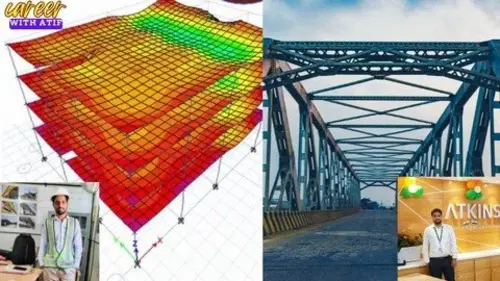Building To Bridge Design: A Career Shift Roadmap
Master the transition from building design to bridge design with industry insights, experience and Interview Prep!

What you'll learn
Understand the Differences Between Building and Bridge Design
Familiarize with Industry-Standard Codes and Guidelines
Develop a Transition Plan from Building to Bridge Design
Prepare for Bridge-Specific Technical Interviews
Access Resources for Continuous Learning and Upskilling
Understand Real-World Applications of Bridge Design
Requirements
For all civil engineers. Specifically targeted for Building structural engineers who are aspiring to shift in Bridge design domain
Description
This course is designed for structural engineers who are currently working in building design and want to transition into bridge design. Whether you're driven by a curiosity about how bridges work or seeking career growth, this course will provide you with the roadmap to make the shift.You will learn the core principles of bridge design, the differences from building design, and Software tools used in bridge engineering projects.
From understanding key design codes required such as IRC and CBC to Correlating design principles from Building design, this course covers everything you need to know.We’ll also delve into real-world case studies, industry interview questions, and resources to upskill.
By the end of the course, you will be equipped with the knowledge and skills to confidently pursue opportunities in bridge design.Key takeaways:Discover the differences between building and bridge design.Learn how to apply your existing structural knowledge to bridge projects.
Know about Tools used in bridge design.Understand critical design codes like IRC and CBC.Prepare for bridge design interviews with real-life interview experience and my journey.Know about valuable resources for continuous learning and career growth in bridge engineering domain.Get yourself enrolled in the course and get ready for the career shift.
Overview
Section 1: Introduction
Lecture 1 Course Overview
Lecture 2 Instructor Introduction
Section 2: Should You Shift to Bridge Design?
Lecture 3 Why Shift from Building to Bridge Design?
Lecture 4 Key Differences Between Building and Bridge Design
Section 3: How to Make the Transition?
Lecture 5 Roadmap
Lecture 6 Important Bridge Design Codes
Lecture 7 Get Professional Trainings
Lecture 8 Key Software for Bridge Design
Section 4: Upskilling Resources in Bridge Engineering
Lecture 9 Excellent Books to Learn Consulting Practices
Lecture 10 Online Resources & Communities
Section 5: Interview Preparation
Lecture 11 How to Gauge Knowledge Acquired? - Interviews
Lecture 12 My First Bridge Design Interview
Section 6: Industry Awareness In Bridge Engineering
Lecture 13 Current Market Trends - 2024
Structural Engineers,Civil Engineers,Bridge Engineers,Graduate Civil or Structural Structural Engineers
Published 10/2024
MP4 | Video: h264, 1920x1080 | Audio: AAC, 44.1 KHz
Language: English | Size: 2.61 GB | Duration: 1h 30m
Download
*
Master the transition from building design to bridge design with industry insights, experience and Interview Prep!

What you'll learn
Understand the Differences Between Building and Bridge Design
Familiarize with Industry-Standard Codes and Guidelines
Develop a Transition Plan from Building to Bridge Design
Prepare for Bridge-Specific Technical Interviews
Access Resources for Continuous Learning and Upskilling
Understand Real-World Applications of Bridge Design
Requirements
For all civil engineers. Specifically targeted for Building structural engineers who are aspiring to shift in Bridge design domain
Description
This course is designed for structural engineers who are currently working in building design and want to transition into bridge design. Whether you're driven by a curiosity about how bridges work or seeking career growth, this course will provide you with the roadmap to make the shift.You will learn the core principles of bridge design, the differences from building design, and Software tools used in bridge engineering projects.
From understanding key design codes required such as IRC and CBC to Correlating design principles from Building design, this course covers everything you need to know.We’ll also delve into real-world case studies, industry interview questions, and resources to upskill.
By the end of the course, you will be equipped with the knowledge and skills to confidently pursue opportunities in bridge design.Key takeaways:Discover the differences between building and bridge design.Learn how to apply your existing structural knowledge to bridge projects.
Know about Tools used in bridge design.Understand critical design codes like IRC and CBC.Prepare for bridge design interviews with real-life interview experience and my journey.Know about valuable resources for continuous learning and career growth in bridge engineering domain.Get yourself enrolled in the course and get ready for the career shift.
Overview
Section 1: Introduction
Lecture 1 Course Overview
Lecture 2 Instructor Introduction
Section 2: Should You Shift to Bridge Design?
Lecture 3 Why Shift from Building to Bridge Design?
Lecture 4 Key Differences Between Building and Bridge Design
Section 3: How to Make the Transition?
Lecture 5 Roadmap
Lecture 6 Important Bridge Design Codes
Lecture 7 Get Professional Trainings
Lecture 8 Key Software for Bridge Design
Section 4: Upskilling Resources in Bridge Engineering
Lecture 9 Excellent Books to Learn Consulting Practices
Lecture 10 Online Resources & Communities
Section 5: Interview Preparation
Lecture 11 How to Gauge Knowledge Acquired? - Interviews
Lecture 12 My First Bridge Design Interview
Section 6: Industry Awareness In Bridge Engineering
Lecture 13 Current Market Trends - 2024
Structural Engineers,Civil Engineers,Bridge Engineers,Graduate Civil or Structural Structural Engineers
Published 10/2024
MP4 | Video: h264, 1920x1080 | Audio: AAC, 44.1 KHz
Language: English | Size: 2.61 GB | Duration: 1h 30m
Download
*